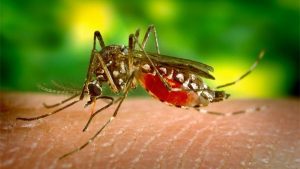When asked what the year’s tick season might be like in April 2019, Theodore G. Andreadis, Director of the Connecticut Agricultural Experiment Station replied, “It’s always bad.” Biting, nearly-invisible ticks are a big headache for Connecticut residents.
But what are ticks, really, and what makes them bad?
For starters, ticks aren’t insects. They’re arachnids. Like spiders (which are also arachnids), they have neither antennae nor wings. They don’t fly, jump or sting – and they don’t spin webs, either! Ticks go through four life stages: egg, larva, nymph, and adult. At each stage, the tick needs blood to survive, and they can get that blood from mammals, birds, reptiles or amphibians. A tick will seek out a new host at each stage of its life.
How does a tick find its new hosts? They use a strategy called “questing” – they cling to a blade of grass or a leaf, extend their forelegs, and grasp onto the passing host. Once on the host’s body, they’ll find a thin patch of skin over a blood vessel and latch on. (Note that while ticks are known for hiding out in tall grass, they actually live in trees, shrubs and leaf piles, too.)
When a tick bites, it inserts its mouthparts (yes, that is a technical term) into your skin. It has long, sword-like teeth that it burrows deep into the skin to really hang onto you, the host, for days. Some ticks even secrete a cement-like fluid to ensure they stay in place! A tick will stay stuck to your skin, drinking blood until its completely engorged, and then it drops off. Fortunately, ticks tend to be quite tiny – and they secrete numbing fluids – so not only will you not feel a single tick biting you, it won’t take very much blood. (National Geographic has a detailed, somewhat stomach-churning video and description of how a tick feeds on their website for those brave enough to learn more!)
Most ticks are harmless, but just to be safe…
While most tick bites are harmless, they are seriously creepy. Some people are simply allergic to ticks, and in those folks, ticks can cause rashes, swelling, redness and even difficulty breathing. And, as we know, they can cause diseases too. Lyme disease, carried by ticks, is the most common “vector-borne disease” in the U.S., infecting 300,000 people a year in the U.S., according to the CDC. Tick-borne illnesses don’t reveal their symptoms immediately, so if you do get bitten, contact a doctor if you experience fever, chills, nausea, weakness, headaches or other unusual symptoms within. Keep in mind that symptoms may present themselves any time from within two days to up to eight weeks, so be vigilant. You should also familiarize yourself with the symptoms commonly associated with Lyme Disease, just in case.
If you do find a tick on your body or a family member’s, remove it immediately and send it to CAES for evaluation. Detailed instructions for tick submission are on the state website.
But again – most tick bites are innocuous, so don’t panic if you do get bitten!
The most common ticks in Connecticut are:
- Black-legged tick (also known as the deer tick)
- Dog tick (also known as wood tick)
- Lone star tick
- Brown dog tick
We’ll learn more about these, the problems they can cause, and how to protect your property and loved ones from them in upcoming blog posts.
Until then, please feel free to contact us about our eco-friendly tick sprays!





